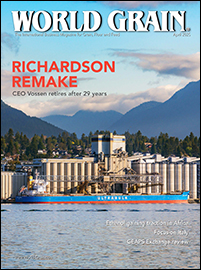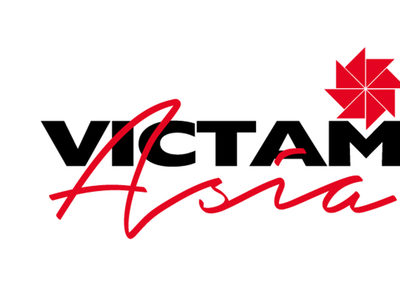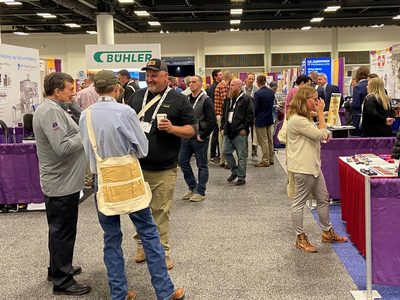The purifier was developed for use in the wheat milling industry in the mid to late 1800s and came to be an essential component of mills processing hard wheat into white flour. It is said that the gradual reduction processing used in wheat milling could be fully developed only after the invention of the purifier.
If you try to make a high percentage of low-ash flour, you can have more success by incorporating purifiers into the mill flow than any other way. Considering the three basic machines used in the milling section of flour mills — roller mills, sifters and purifiers — it is the purifier that is the most denigrated. It is much easier to misuse a purifier than a roller mill or a sifter. In fact, if you try to be very careful in the application of the operation principles of these three types of machines, it seems the purifier can cause more frustration than the other two combined. This is partly because the proper operation of the purifier is dependent on the proper operation of both the roller mill and the sifter.
THE PURIFIER PROCESS
At the beginning of the purifier process, stock enters the purifier via an oscillating feeder tray, and it is there that the particles begin to stratify. Coarse particles move to the top and small particles to the bottom. The particles not only have different sizes, they have different densities, with endosperm particles being denser than bran particles. Although fine particles are less likely to be "branny" than the coarse ones, there is still plenty of fine branny particles to challenge millers, because fine branny particles can get dragged through an opening in the dead air just above the larger ones.
The motion of the purifier deck is fairly gentle, especially compared to the motion of a high-capacity, free-swinging sifter. Purifier decks move in short longitudinal strokes with a little upward kick as particles move to the tail end of the machine.
In purifiers, you have air moving upward from the bottom of the sieve compartment to the top. If you have the aspiration set properly, there will be a small but steady stream of air passing from below the sieve compartment upward through all the decks — just enough air velocity to cause a mild bubbling of stock on the sieves. If a machine requires 1,900 cfm of aspiration air to function, which is typical, and each sieve is about 20 square inches, then the average velocity through the sieve compartment is only about 88 feet per minute, which is really not very much air flow.
Smaller particles are going to fall through the screen openings much easier than the larger particles no matter what you do. If you have a branny particle that’s half as big as the screen opening, it’s going to fall through the opening just as easily as a 100% endosperm particle that’s almost as big as the opening. That’s why fines in purifier stock are a major problem. They’ll just defeat your purpose, which is why it is essential to keep fines out of purifier stock if at all possible.
Almost every purifier has aspiration micro-adjustments, usually about four of them for every sieve along the deck of the purifier. Of course, every purifier has macro-adjustments that set the quantity of air for the whole sieve compartment. Some manufacturers provide instructions for setting micro-adjustments. It is never a good idea to deviate from those recommended settings. Millers who set micro-adjustments more than half or nearly wide open will almost surely run into problems; they should almost never be set more than one-fourth of the way open. The biggest openings should be in the compartments that are farthest away from the macro-adjuster, which is where the main trunk takes off, and then gradually taper down the openings as you get closer to the trunk pick-up point.
There are lots of reasons for not using more air than you absolutely need. When you get any of the micro-adjustment openings too far open, you lose control of the air and the air is going to follow the path of least resistance, which means most of the time it is going where you don’t want it to go.
If you can see a gentle boiling of stock along the top deck, you’ve got about the right amount of aspiration on the machine. However, if bran is shooting up and striking the window, you’ve got too much in that area so you should throttle back just a little.
If you have dust accumulating in the aspiration chamber above the sieve compartment, open the vents at the head end and the tail end of the machine. That should emit enough air to carry away the dust that aspirates out of the sieve compartment.
It’s also important to remember that if the filter handling the aspiration from the purifiers is not working properly, you are going to have problems. If you can’t make the filter operate trouble-free with constant air flow, you’re never going to get your purifiers to work right.
MAINTAINING A SMOOTH LOAD
It is essential to maintain a smooth, surge-free load on the purifier. One of the ways to try to keep a smooth load on the purifiers is to spout one or two sifter sections directly to each half of the purifier. If you have good stock distribution to the sifter sections, then you’ll have a smooth load on each part of the purifier.
However, if you can’t locate purifiers directly below the sifters that feed them, then it is better to use a motorized stream splitter to ensure that you have a uniform load to the machine. If you keep in mind that you’re trying to match up the number of openings in the purifier cloths with the number of particles that you’re dealing with, you’ll see that it’s really important to maintain a constant, smooth load on the machine.
You want to have a gradually lighter load on each deck as you move from the head end of the purifier to the tail end. If the quantity or granulation of the stock changes, you are going to be frustrated. You must keep the stock spread over the full width of the deck. For a purifier to function properly, maintaining an even air velocity is very important, and the only way to do that is to maintain an even load on the purifier deck.
If you are having trouble with bare spots on one corner of the deck or along one side of the sieve, make sure the sieve deck is level from side to side. On older purifiers, where sieve decks run on adjustable hangers, try to adjust the hangers so you always have the deck level from side to side. Try to have about the same pitch or angle on each pair of hangers. However, the front pair can have a different angle than the back pair. Hanger bearings must be in good condition. Worn bearings will cause a lot of trouble when it comes to properly balancing the sieve decks.
Modern sieve decks run on rubber springs, and it’s important to make sure you are using the type of springs that the manufacturer recommends and have the purifier mounted level on a firm floor.
Purifiers should be set up to allow a moderate amount of stock tailing off each deck. A bare or nearly empty cloth cannot be tolerated. If you have a triple deck machine, it is better to have a little bit of stock coming off of every deck or you are not using the machine properly.
If the stock tailing off the deck is too branny or too poor in quality, give the machine a little more aspiration. If that doesn’t work, pull the deck out and choose cloths that are one cloth number finer.
QUALITY CONTROL
If you aren’t picky about the kinds of stock your equipment is producing, then you will likely end up with an end product that is not satisfactory. This is especially true when working with purifiers.
It’s important to check the products coming out of the machine on a regular basis. Do this as soon as possible after starting up after repairs and every few days after that. You may want to catch the throughs of each bottom sieve along with the tailouts of each deck and place them side by side in proper sequence on a level surface to compare them. If the product looks different than it’s supposed to, open up the deck and inspect the sieves, brushes and other parts of the purifier.
You should never keep the machine running if it’s doing a bad job. That’s how purifiers get a bad name.
It’s important to note that purifiers should never be run faster than the manufacturer’s recommendations unless you want them to fall apart. They should be kept down to 550 to 600 cycles per minute.
KEEPING THE CLOTH CLEAN
The cloth in the purifiers must be kept clean. The types of particles running through them, being sharp and angular, are prone to lodge in the cloth openings. Therefore millers use either brushes or balls for screen cleaning.
Brushes can last many years if cared for properly. Do not store new brushes in a bag, box or drawer where their bristles can get snarled or jammed in the corner. If bristles become frazzled or bent, they won’t enter and leave the cloth opening smoothly, and they will probably hang up and not move across the sieve frame from end to end like they should.
When receiving a shipment of spare brushes, moisten the brushes just a little, comb the bristles into proper shape and place them in a special rack. A rack takes up more space than the box the brushes are shipped in, but two or three racks can be stored in a typical sieve cabinet drawer and are fairly easy to keep clean.
If bristles are worn, you will have to replace the brush. When installing a brush into a purifier, always insert the brush in a manner that does not snag the bristles. Always make sure the brush can travel the full length of the sieve, hit the turning lever, return to the other end and turn that corner, too. You can do this by holding the sieve in front of you and oscillating it back and forth gently.
Never leave sieves in a purifier for more than two weeks without removing them and scraping off any stock that sticks to the perimeter of the cloth and the frame. Inspect the movement of the brush, making any corrections that are needed before reinstalling them. You can remove all the sieves from one deck of the purifier while it is running without noticeably affecting the mill performance.
If a brush begins to wear out, it will leave streaks of plugged openings in the sieve. Often it will lose traction and stop moving, resulting in it being stuck at one point of its travel.
Many millers have reported good results using ball cleaners in purifier sieves. A typical purifier sieve will have four ball compartments. The borders of those ball compartments have a tendency to become plugged and therefore require regular manual brushing. Borders that become plugged will retard the flow of stock over the deck. That makes it even harder to keep the throughs clean and free of branny particles.
Royal Denning is past president of the International Association of Operative Millers. He can be reached at [email protected].




